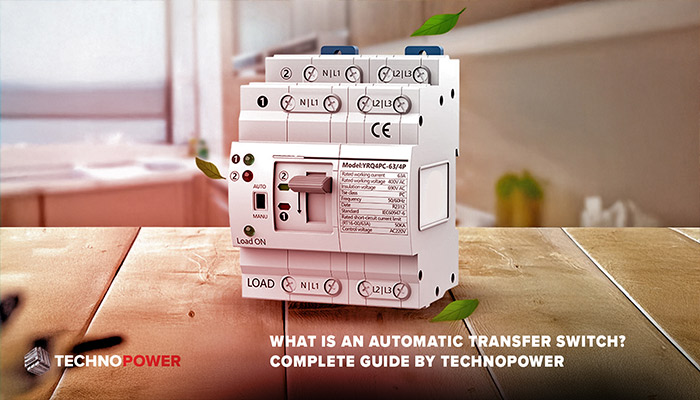When it comes to ensuring uninterrupted power during an outage, having a backup generator alone isn’t enough. A crucial device called an Automatic Transfer Switch (ATS) plays a key role in seamlessly transferring the power source from the utility grid to the generator.
But what is an Automatic Transfer Switch exactly, and why is it so important?
In this complete guide, we’ll cover everything you need to know about ATS systems, how they work, their benefits, types, and why installing one is essential for both residential and commercial setups.
What is an Automatic Transfer Switch?
An Automatic Transfer Switch (ATS) is an intelligent electrical device that automatically detects a power outage and switches the load from the main utility supply to a standby generator. Once normal power is restored, the ATS switches the load back to the utility grid without requiring manual intervention.
In essence, when you ask what is an Automatic Transfer Switch, the answer is simple: it's the brain that ensures your backup generator activates at the right time, offering peace of mind during unexpected outages.
For high-quality solutions, you can check Technopower’s advanced ATS Control Panel designed to optimize automatic switching between power sources.
How Does an Automatic Transfer Switch Work?
Here’s a step-by-step overview of how an Automatic Transfer Switch operates:
Monitoring: Constantly monitors the incoming utility power.
Detection: Detects loss or fluctuation in power supply.
Command: Sends a signal to start the standby generator.
Switching: Disconnects from the utility and connects the electrical load to the generator.
Reconnection: Once stable utility power is restored, it switches back from generator power to the grid.
This seamless operation ensures that sensitive systems, critical machinery, and residential essentials stay powered with minimal disruption.
Why You Need an Automatic Transfer Switch
Understanding what is an Automatic Transfer Switch helps in realizing why it’s indispensable:
Automatic Response: No need for manual startup or switching during an emergency.
Enhanced Safety: Prevents back-feeding which could endanger utility workers.
Protects Equipment: Smooth transitions prevent surges and damages.
Convenience: Offers hands-free management of your power backup system.
Reliability: Critical for hospitals, data centers, and industrial operations where even seconds of downtime can be disastrous.
Types of Automatic Transfer Switches
There are different types of ATS configurations depending on your needs:
Open Transition ATS
Also called "break-before-make," it disconnects from the utility before connecting to the generator, ensuring no back-feed.
Closed Transition ATS
This type briefly connects both sources (utility and generator) to ensure no power loss during transfer, ideal for critical operations.
Delayed Transition ATS
Designed for systems that require a pause before switching back to utility power, allowing sensitive equipment to shut down properly.
Soft Load Transfer Switch
Enables paralleling between the generator and utility power for load sharing during peak periods.
Choosing the right type of ATS depends on your system requirements, load sensitivity, and application.
Related Keywords
Generator Automatic Transfer Switch
Home ATS Panel
Industrial ATS Systems
Standby Generator Transfer Switch
Best ATS for Generators
These related terms are crucial when searching for the right setup for different applications.
FAQs About Automatic Transfer Switches
What is the purpose of an Automatic Transfer Switch?
An ATS ensures an automatic, safe, and efficient transition between utility power and a backup generator without manual intervention.
Do I need an ATS for my home generator?
Yes, especially if you want an automatic and seamless power transition during outages without manual effort.
What is the difference between a manual and automatic transfer switch?
A manual transfer switch requires you to physically flip the switch during an outage, whereas an ATS automatically manages the transfer, ensuring continuous power.
Can an ATS be used with any type of generator?
Most ATS units are compatible with standby and prime generators, but it’s important to match the switch rating with the generator’s capacity.
Applications of Automatic Transfer Switches
Residential Homes: Ensuring essential systems like refrigerators, lights, and security remain operational.
Healthcare Facilities: Keeping life-saving equipment powered at all times.
Data Centers: Preventing data loss and downtime.
Industrial Facilities: Maintaining production and operational safety.
Commercial Buildings: Keeping businesses functional during outages.
Conclusion
Understanding what is an Automatic Transfer Switch is essential for anyone looking to safeguard their property or business from unexpected power failures.
An ATS offers automatic, safe, and efficient switching between power sources, making it an indispensable component of any reliable backup power system.
At Technopower, we provide top-tier ATS Control Panels designed to meet a wide range of residential, commercial, and industrial needs.
Explore our solutions today and ensure your power never skips a beat!


